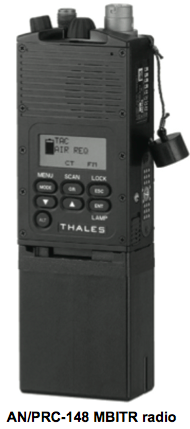AN/PRC-148
Contents
AN/PRC-148 MULTIBAND INTER/INTRA TEAM RADIO

The multiband inter/intra team radio (MBITR) is used for company size nets depending on command guidance and mission requirements. It also has the capabilities of being used as a handheld radio to support the communications of a platoon, squad or team tactical environment for secure communications. It enables small unit leaders to adequately control the activities of subordinate elements. The MBITR can perform functions such as ground to air, ship to shore, SATCOM, civil military and multinational communications. The MBITR was first developed for use by SOF but many units throughout the Army (and other multinational governments) have seen an influx of the radio due to its value.
The MBITR radio set communicates with similar AM and FM radios to perform two-way communication. The AN/PRC-148 was built for frequency and waveform interoperability with legacy and newer systems (Joint Tactical Radio System [JTRS]). The radios concept was to ensure interoperability with virtually any common US military or commercial waveform operating in the 30–512 MHz frequency range with either FM or AM radio RF output, and with a user selectable power output from 0.1–5 watts. The AN/VRC-111 is the vehicular version of the MBITR. (Refer to Figure 4-15 for an example of the MBITR radio.)
The MBITR is a portable, battery operated transceiver capable of providing both secure and non- secure communications. The MBITR operates in clear (analog) and secure (digital) voice and data. The basic radio is software upgradeable to add the following capabilities: SINCGARS, HAVEQUICK, ANDVT, and wireless network extension.
- The MBITR has the following operating characteristics
- Stores up to 100 preset channels organized in 10 groups with 16 channels each.
- SINCGARS voice and SIP data interoperable.
- HAVEQUICK I/II interoperable.
- ANDVT interoperable.
- Transmits voice in a whisper mode.
- Transfers configuration information to other MBITRs by means of a cloning cable.
The radio is tunable over a frequency range of 30–512 MHz, in either 5 or 6.25 kHz tuning steps, using 25.0 kHz channel bandwidth, 12.5 kHz when set for narrowband operation, and 5 kHz bandwidth when set for ANDVT. The radio automatically selects the correct tuning size.
The RT consists of a SC modulated carrier. The modulating source is analog or digitized voice and data signals at 12 (Federal Standard-1023) and 16 kbps (VINSON-compatible) in 25 kHz channel spacing. For emergency situations the radio circuitry is capable of receiving clear messages while set for secure mode operation.
AN/PRC-148 MBITR COMMUNICATIONS SECURITY
When operating in the secure mode, the radio disables the transmission of any tone squelch signals. Encryption key fill is accomplished through the audio/key fill connector. The urban MBITR has a standard U-283/U six-pin connector that is fully compatible with the following key fill devices: KYK-13, KYX-15, KOI-18, and the AN/CYZ-10 (data transfer device [DTD]).
AN/PRC-148 MBITR and SINCGARS
SINCGARS operation is only available in those radios with the optional SINCGARS capability enabled. The following describes the transmission security (TRANSEC) capabilities of the MBITR with SINCGARS option
- When operating in the SINCGARS mode, the available MBITR operating frequency range is 30–87.995 MHz.
- MBITR with SINCGARS functionality includes the operating modes of the basic MBITR radio and the following modes of operation
- SC clear FM analog voice operation, FM encrypted digital voice, and over- the-air FM transfer of encrypted digital data. The SC data mode implements the SINCGARS standard data mode and EDM.
- FH PT digital voice operation, FH FM encrypted digital voice in 16 kbps continuously variable slope delta mode, and, using the SINCGARS and SINCGARS SIP waveforms, FH over-the-air FM transfer of encrypted digital data
AN/PRC-148 (MBITR) System Management
System management of the MBITR is the responsibility of the S-6 or communications section at all echelons. A Windows based personal computer (PC) radio programmer is provided to manage the quantity of radios. While all radio functions can be accomplished through the individual radio control panel if required, it would be very difficult to set up the radios for a battalion or larger force manually using radio front panel controls.
The PC programmer has a simple Windows “look and feel” interface that allows uploading and downloading information such as assigned frequency lists, waveform data, power level etc. to the radio. Once a radio is loaded with system information, it can be used to distribute this information (clone) to another MBITR. This cloning feature allows the S-6 system manager to distribute technical information down the tactical echelons to each individual radio in a command without fear of mistakes being made or data being corrupted.
AN/PRC-148 MBITR in Urban Operations
In small tactical units area coverage and distance extension has always been a problem. In urban operations communications inside buildings or over urban terrain has been a challenge. For these conditions the MBITR system provides a “back-to-back” (two radios) wireless network extension capability for both COMSEC and PT modes. Beside two radios, the only hardware required for wireless network extension is a small cable kit and some electronic filters. When configured for wireless network extension operations, a true digital repeater (digi-peater) is formed. Since the digits transmitted are merely being repeated by the radios they do not degrade signal quality and the radios do not have to have any COMSEC keys loaded in them.